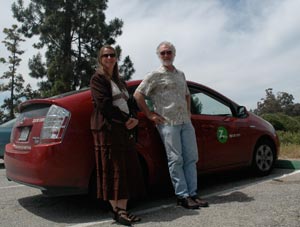Kaitlin Ashley's car broke down two years ago, and she didn't have the money to fix it.
So the 21-year-old Santa Cruz resident, whose partner is a full-time UCSC student, looked into getting a new one. Then along came Zipcar.
The car-sharing service partnered with UCSC in September to put a total of seven vehicles on the UCSC campus, at 2300 Delaware Ave., and in a downtown Santa Cruz lot. Members pay an application fee, an annual membership fee (waived for UC affiliates), and an hourly or daily rate to use the cars.
The service eliminated Ashley's need to buy a car - and pay for upkeep, maintenance, fees, and insurance, not to mention parking permits and ever-more-expensive gas.
Now, Ashley, who works near her home in downtown Santa Cruz, reserves a car when she needs it for trips to Costco or IKEA, or to visit family. Owning a car, she said, is just "not worth it."
Turns out, so many students, faculty, staff, and community members agree with Ashley that the Zipcar service brought to campus and environs by UCSC has become the most well-utilized and fastest-growing car-share program of any university in the nation.
Because of that success, Zipcar is now expanding its UCSC program, sending two to three more cars in May to join the current fleet.
"Give us a little time, and this program is gonna spread like wildfire," said Larry Pageler, director of Transportation and Parking Services.
UCSC's cars consist of three Toyota Priuses, two Honda Elements, a Toyota Matrix, and a Mazda3. The new cars will likely include another Prius, as well as another Mazda or Matrix, or both.
And if things continue to go well, Zipcar could add even more cars.
"Zipcar plans to expand as necessary," said Jenny Larios Berlin, general manager of universities at Zipcar. "If, after we add the additional cars we still see a high utilization rate, we will add vehicles to the fleet."
In late April, Pageler also announced that Zipcars can now also be used for short-term UC business-related trips.
The reason for the program's rapid growth here is twofold, said Teresa Buika, campus transportation planner.
"One of the main reasons it's so successful is we have a lot of residential freshmen and sophomores, and they're prohibited from bringing cars to campus," she said.
The campus barred residential freshmen and sophomores from having cars on campus years ago as a congestion-cutting and parking-relief move. About 75-80 percent of students living on campus are freshmen and sophomores.
Also, she said, the program has "kind of a 'green' focus," with its Priuses and other fuel-efficient cars and its business model of shared resources.
Many of the people using the service "are conscious of their carbon footprint and concerned about climate change, and want to make sustainable "green" choices," said Pageler.
Studies by Zipcar have shown that their car-sharing programs have many "green" benefits to campuses and local communities. Each Zipcar typically replaces up to 20 personally owned vehicles, reducing the need for additional parking spaces and replacing older vehicles with new ones that have more stringent pollution controls. Zipcar members tend to drive significantly less, resulting in less congestion and fewer greenhouse gas emissions. Members tend to use a variety of alternative modes and use Zipcar only when they need to.
Zipcar member Ashley likes the environmental aspect, but also the convenience factor.
"Whenever I want, I can book it and do a trip real fast," she said. "And it's like a little vacation. You can put your CD in and drive around, you don't have to worry about insurance and gas--it's nice."
UCSC's Zipcars are used on average 42 percent of the time, said Pageler. On weekends, usage can rocket to 85-90 percent. Zipcar typically looks at expanding its programs once they get to 45-50 percent utilization; UCSC was hitting that mark within two to three months, said Pageler.
The quick ramp-up is a convergence of a few key elements, said Zipcar's Larios Berlin.
"The university community is alternatively minded and open to eco-friendly solutions," she said. "Also, the program is not that far from one of our major metropolitan markets, which means that the education process is much, much faster, thus expediting the adoption of the program in the community."
UCSC's membership has swelled to 475 users in its seven months.
"With only seven cars in the system, that's pretty remarkable," said Pageler.
His overall aim is increase quality of life on campus and in the community by reducing the number of trips to campus, cutting the campus's impact on the environment, and decreasing parking demand both on campus and in adjacent neighborhoods.
Ultimately, he'd like to see the program expand further into the community.
"We'd like to see car-sharing accommodate community members who might not need a second car, or any car at all," Pageler said. "If we can help spread that benefit, it's a win-win for everyone."
For information about the Zipcar program at UCSC, visit the campus's Zipcar page.
Contact the author at gwenm@ucsc.edu.



